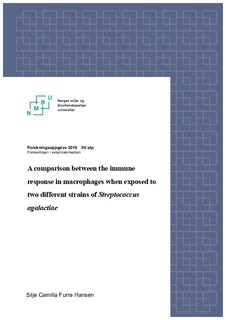| dc.description.abstract | Abstract of thesis Mastitis is the most common disease in the dairy industry today. In the mammary gland, macrophages play a leading role in the immune response as first line defence against invading udder pathogens. Different candidate genes associated with the response against udder pathogens are detected, where some of these candidate genes represent pro-inflammatory cytokines produced by macrophages. However, recent studies from our group indicate that macrophages infected with bacteria such as Staphylococcus aureus also produce anti-inflammatory cytokines in an alternative response. The alternatively activated macrophages counteract many pro- inflammatory mechanisms, and this may be a strategy for udder pathogens to evade the host immune response. A key question is whether macrophages exposed to Streptococcus agalactiae will have a greater inclination towards alternative than classical activation, and if this diversify between the different sequence types (ST) of the bacteria. We investigated the early phase response of bovine monocyte-derived macrophages infected in vitro with two different sequence types of live Streptococcus agalactiae (ST103 and ST12) in vitro, by examining the transcription level of six macrophage-associated cytokines. First, we isolated monocyte-derived macrophages from six healthy Norwegian Red (NR) cows aged 2,5-7 years, and for each individual animal the immature macrophages were divided into four classes. Two classes were infected in vitro with either of the two S. agalactiae strains with a multiplicity of infection (MOI) of 1, then incubated for 1 hour before penicillin/streptomycin was added in each well, and further incubated for 5 hours (a total of 6 hours). The third cell class was exposed to Lipopolysaccharides (LPS) (positive control) and the last class was left uninfected (negative control), and both positive and negative control were treated equally as the infected cells with penicillin/streptomycin and incubated for a total of 6 hours. Originally, we planned to compare the early phase response also with monocyte-derived macrophages infected with Staphylococcus aureus in vitro, but we were not able to continue this work due to a non-reproducible method when infecting the cells with S. aureus. Consequently, this part of the study was abandoned. Further we isolated total RNA from the cells infected with S. agalactiae ST12 and ST103, and measured the transcript levels of Tumor Necrosis Factor α (TNFα), Interleukin 1β (IL-1β), Interleukin 6 (IL-6), Interleukin 8 (IL-8), Interleukin 10 (IL-10) and Transforming growth factor β1 (TGFβ1) by Reverse transcription-quantitative Polymerase Chain Reaction (RT-qPCR). TNF-α, IL-1β, IL-6, IL-8 and IL-10 were significantly up-regulated by ST12, ST103 and LPS compared to the negative control. IL-6 and IL-10 displayed different responses both between ST103 and LPS, and between ST12 and LPS, with high levels of IL-10 (anti-inflammatory cytokine) and low levels of IL-6 (pro-inflammatory cytokine) in the cells infected with S. agalactiae compared to cells activated by LPS. TGFβ1 were significantly down-regulated only in the macrophages infected with ST12. When comparing the transcription levels of the cytokines between the macrophages infected with the two strains of S. agalactiae, we did not observe significantly different expression of any of the six cytokines. Thus, we know there is activation of both pro-inflammatory and anti-inflammatory cytokines when infected with S. agalactiae, and that there is a decrease in the anti-inflammatory signal of TGFβ1 only in macrophages infected with ST12. We also propose that the macrophages infected with bacteria might be activated in the alternative pathway compared to macrophages activated by LPS, but this field of study needs further investigation compared to macrophages activated by LPS, but this field of study needs further investigation. | nb_NO |

